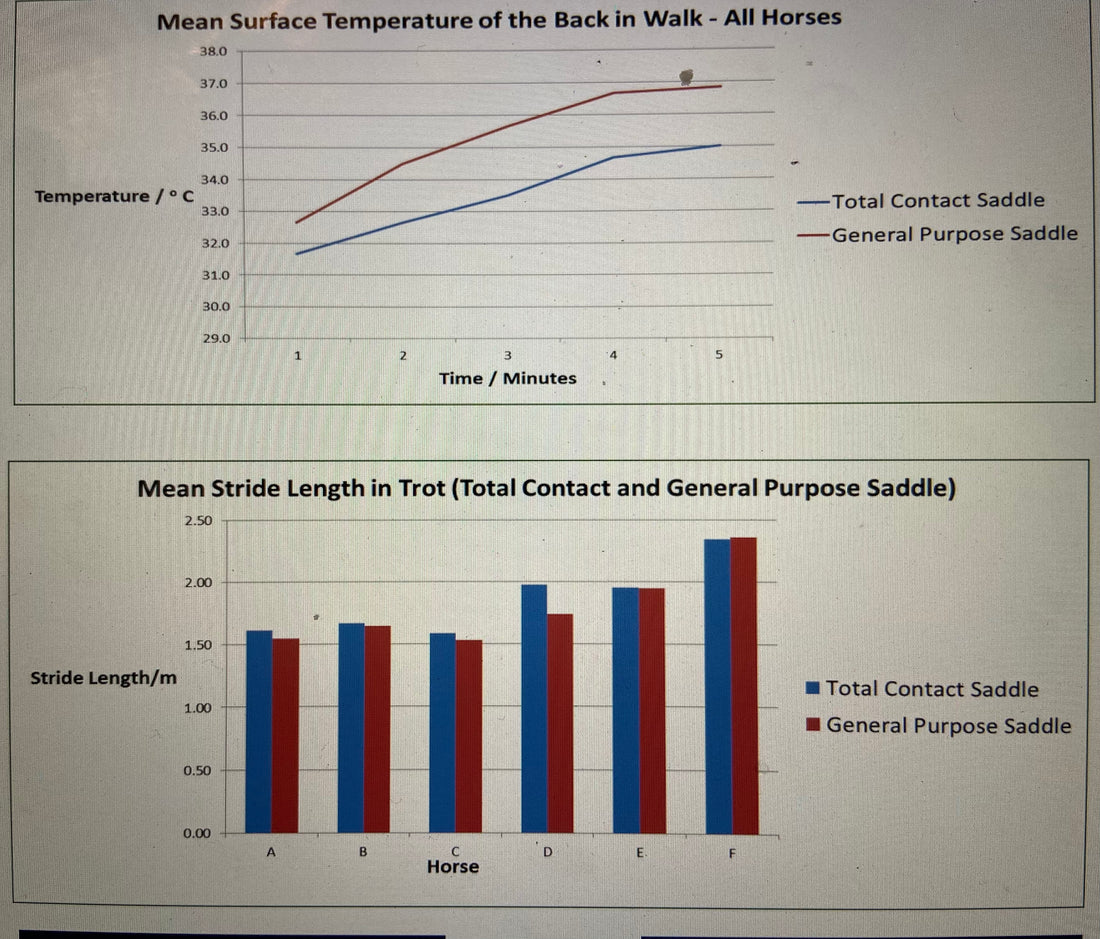
A pilot study into the effect of a GPS and treeless saddle on the temperature of the horse’s back and its freedom of movement
Share
A pilot study into the effect of a GPS and treeless saddle on the temperature of the horse’s back and its freedom of movement. Sophie Keepax, Stuart Attwood, Jessica Berry, Hadlow College, UK
Introduction The welfare of domesticated horses is becoming an increasing concern within the equine industry. One aspect that has been highlighted is the horse-saddle-rider interaction (Clayton, 2013) and whether the horse is being ridden with or without a saddle, studies have shown that this interaction has an impact upon the horse’s back (Arruda et al, 2011). The saddle has also been shown to have an impact upon the horse’s gait (deCocq et al, 2006). Many people have turned to treeless saddles due to the fact that they are more flexible than general purpose saddles and therefore are able to conform to the shape of the horse’s back. Despite this, evidence suggests that treeless saddles concentrate the pressure over a smaller area (Belock et al, 2012). This study aimed to investigate the effects of the Total Contact saddle on the surface temperature of the equine back and freedom of movement (determined by shoulder angle and stride length) in comparison to the effects induced by general purpose saddles.
Materials and Method A treed Wintec (GPS) and a treeless Total Contact Saddle (TCS) were used. The impact of heat variations on the back was also measured as this is a possible indicator of pain/inflammation. A random selection of six horses from a riding school population was chosen, and each horse was ridden by the same rider for 10 min in walk and trot in an indoor school. Temperature was recorded at the start of the activity by way of a digital thermocouple - figure one shows the thermocouple under the Total Contact saddle. - and every minute after from an area equivalent to that under the seat bones of the rider and on the horse’s skin. The use of a high speed video camera (Sports Motion Video Analysis System) allowed stride characteristics to be taken from marked areas on the horse. A thermographic camera was also used to identify any ‘hot spots’ on the horse’s back post exercise. The horses were first ridden in their own GPS saddle and then the Total Contact Saddle with a period of time between each effort to allow the horse’s back to come back to a base level. A Wilcoxon Signed Ranks Test was used to analyse the data collected using SPSS software.

Discussion There was a significant difference between the effect that the general purpose saddle has on gait and back temperature in equines in comparison to the effect elicited by the Total Contact Saddle). It is possible that regarding surface temperature of the equine back, the general purpose saddle resulted in the greater increase due to the fact that it had a greater surface area with flocking which may have an insulating effect. The fluctuating temperature in trot may be a consequence of the fact that the rider was rising. Therefore, airflow may have influenced the readings (Westermann et al, 2013). The thermographic images in Fig. 4 and 5 demonstrate the hot spots in each saddle; these were typically higher in the general purpose saddle. In the general purpose saddle hot spots were typically located around the knee roll which may be a consequence of saddle fit or riding style. In the Total Contact saddle they were typically located where the rider’s seat or lower leg was positioned; this indicates that they were likely to have been generated by the rider being in direct contact with the horse as opposed to the saddle. The increased range of movement induced by the Total Contact saddle would be beneficial to trainers and riders who aim to produce movements that conform to the requirements of competitions (Rose et al, 2009). Further studies would be required in order to determine the cause of the kinematic changes.
Results The results showed that when in walk, the surface temperature of the back increased whilst the horses were being worked, both in the general purpose saddle and the Total Contact saddle. However, the temperature with the general purpose saddle was significantly higher than the Total Contact saddle (p=0.042) as shown in figure two. In trot, the temperature fluctuated but was still significantly higher in the general purpose saddle (p = 0.026). When analysing the effect on the stride length in walk, it could be seen that all horses either kept their stride length the same in either saddle or their stride length increased when wearing the Total Contact saddle. The increase in stride length was significant (p = 0.042). The greatest improvement was shown in horse D with an increased stride length of 0.15m when wearing the Total Contact saddle. When analysing the results for shoulder angle ranges, it can be seen that five of the six horses had an increased shoulder angle range when wearing the Total Contact saddle. The difference in ranges between saddles was significant (p = 0.046).


Conclusion Contrary to previous studies, the Total Contact saddle was shown to have a lesser impact on the back in comparison to the general purpose saddle as indicated by the significantly lower surface temperature of the back (p=0.042). The discovery of a high temperature in a localised position is a well accepted indicator of pain (Taylor et al, 2002). Therefore, the implication is that riding in a Total Contact saddle compared to a general purpose saddle is beneficial to the welfare of the horse. The results of this study also showed an increase in both stride length and shoulder angle when the horses were ridden in the Total Contact saddle. This is beneficial for equine trainers who aim to produce gaits from horses that meet the requirements of competition (Rose et al, 2009).
References Arruda, T.Z., Brass, K.E. and De La Corte, F.D. (2011). Thermographic Assessment of Saddles Used on Jumping Horses, Journal of Equine Veterinary Science, 31, pp: 625 – 629 Belock, B., Kaiser, L.J., Lavagnino, M. and Clayton, H.M. (2012). Comparison of pressure distribution under a conventional saddle and a treeless saddle at sitting trot, The Veterinary Journal, 193, pp: 87 – 91 Clayton, H.M. (2013). Science in brief: Interactions between the rider, the saddle and the horse, Equine Veterinary Journal, 45, pp: 3 – 4 deCocq, P., van Weeren, P.R. and Back, W. (2006). Saddle pressure measuring: Validity, reliability and power to discriminate between different saddle-fits, The Veterinary Journal, 172, pp: 265 - 273 Rose, N.S., Northrop, A.J., Brigden, C.V. and Martin, J.H. (2009). Effects of a stretching regime on stride length and range of motion in equine trot, The Veterinary Journal, 181, pp: 53 – 55 Taylor, P.M., Pascoe, P.J. and Mama, K.R. (2002). Diagnosing and treating pain in the horse. Where are we today? The Veterinary Clinics – Equine Practice, 18, pp: 1 - 19 Westermann, S., Stanek, C., Schramel, J.P., Ion, A. and Buchner, H.H.F. (2013). The effect of airflow on thermographically determined temperature of the distal forelimb of the horse, Equine Veterinary Journal, Article In Press



